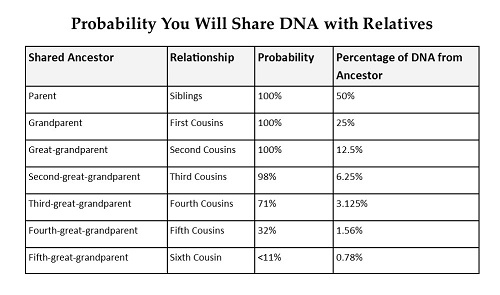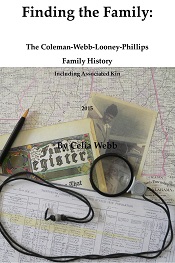DNA Tests for Family History
You have probably seen the advertising promoting DNA testing as a way of learning more about your family history. DNA tests can be useful tools. The tests may be the only way of understanding more about the ancestral lines that lead to you. However, these tests should come with a warning label. First of all, the test in and of itself has limited utility. You will not get a chart listing your pedigree as a result of the test alone. Such a chart will require genealogical research. Secondly, you may learn things that surprise you. Some might be pleasant surprises; others may be things you are not expecting. The advertising never mentions this aspect, of course. A few examples from my genealogy work will serve to illustrate this point.
Example 1: The most common unexpected surprise occurs for people who have ancestry stretching back into the early years of America. Typically this happens when the family lines were in America prior to 1865. The person being tested discovers that they have cousins who are of a different race. Their own pedigree (their line of fathers and mothers) may be a single race with regional breakouts (like a European ancestral line with roots in various regions of Europe). They may discover a fourth cousin who is African-American or, less frequently, Native American. It is a reminder that human beings are all part of the large family of we call humanity.
Example 2: A young woman discovered she was not a genetic match to either of her parents, much to the distress of everybody concerned - herself and her parents. There are two possible explanations. One is that she was sent home from the hospital with the wrong set of parents. The other is that she is an example of a phenomena called a genetic chimera. Work is still being done to understand this and how common it might be. There are a few documented cases where a child is born, immediately DNA tested and the tests show the child is not related to the mother who just gave birth to that child. A theory for this phenomena is that the initial fertilization resulted in twins which then melded into a single fetus. During this process the genes that would ordinarily add to the level of showing a close family tie end up being "muted" by having more distant relatives genes playing a more prominent role. So instead of showing 50% for each parent; there is a higher percentage than usual for a great-grandparent perhaps. All sorts of combinations are possible and lead to results not subject to the usual rules of interpretation.
Example 3: An elderly Caucasian gentleman discovered that his Y-DNA originates from Africa and, additionally, is not related to his other male relatives. Because of the ethnic breakout percentages, the introduction of the Y-DNA was clearly back in Colonial times. The fact that the Y-DNA was not a match for his other close male relatives means there was a previously unknown relationship.
There are three DNA tests useful for genealogy.Types of Genealogy DNA Tests:
Autosomal DNA (atDNA) - The autosomal test identifies your ethnic breakout and people who are a match to you could be from any ancestral line leading to you.
Y-DNA - The Y-DNA test gives you a male haplogroup or a more specific subclade designation from which your direct male line descends. A haplogroup identifies a group of people who descend from a (usually very) distant ancestor. Subclades are divisions within a haplogroup providing more specificity with regard to region of the world where the group originated. Although you are related to everyone who is part of the same haplogroup, the connection may be very, very distant and one you are unlikely to be able to find in written records like birth, marriage, and death records which are a relatively recent phenomenon. Haplogroups are established and identified by a gene mutation that carries forward. Haplogroups are often identified with an area of the world where that group is found. Haplogroups are identified by a combination of letters and numbers. Searching the internet on the haplogroup designation will bring up specifics about the group. For example, M253 is a Northern European group associated with the Vikings and found wherever the Vikings set foot.
Matches to a Y-DNA test will come from your direct paternal line, however, they can be at any level of cousinship and quite far away from you. DNA testing for genealogy purposes report results for a "genealogically significant" period meaning up to about 8 generations. After that both the common DNA material for finding matches and the chance of finding a written record is small.
Mitochondrial (mtDNA) - The mitochondrial DNA test gives you a female haplogroup from which your maternal line descends. Matches will be to your direct maternal line.
Points to consider:
1. DNA testing relies on other people related to you having tested. Check for a surname project. Identify "candidate ancestors" and then identify descendants of that ancestor with whom you could compare DNA.
2. The person being tested may not be biologically associated with the surname that person bears. He may have been adopted or changed his name or been born out of wedlock or by an unadmitted union.
3. Autosomal DNA testing can be useful. One way it can help is by verifying genealogy research on lines which do not fall in either the direct paternal or maternal lines.
4. Close relatives of yours can have different genetic matches. This is because we do not inherit genetic material from every one of our ancestors. The further back the ancestor is in your line, the more likely it is that you do not have any detectable level of their DNA. Additionally, we only inherit parts of the DNA of any particular relative - not the whole sequence. That is why it is so important to have multiple family members test. Close relatives do not always share the same DNA. Two conditions have to be met for you and a particular relative to share a genetic match.
a. Both of you must have inherited the one or more segments of DNA from the same ancestor. The likelihood of having inherited a segment of DNA from an ancestor decreases with each generation separating you from that ancestor. The chart provides the likelihood of sharing detectable DNA.
b. Both of you must inherit at least one of the same segments of DNA in order to be identified as genetic cousins. It is possible that you and a particular relative both inherited DNA from your fifth great grandmother but each of you received different segments. If this happened, you would not show up as genetic matches even though you are, in fact, cousins.

Testing several of your known relatives increases your chance of verifying a genetic link.
Limitations:
1. Y-DNA tests for genealogical purposes are not the same as paternity DNA tests. A Y-DNA test cannot determine whether two people are brothers, cousins, or some other close paternal relationship. So while a Y-DNA test will show a paternal relationship of some sort; it doesn't distinguish it. The exact nature of the relationship must be determined through genealogical research.
2. Your likelihood of randomly matching a fifth cousin is low but still possible. That is why it is helpful to have as many relatives as possible test; both from your known family and the families you believe descend from the possible ancestor.
3. Sharing DNA with a distant cousin is not proof of a particular ancestral line; you may be related to the person through some other shared ancestor. But the match is a piece of evidence that you can analyze with other evidence.
Companies offering some of the tests above include Ancestry.com, 23andme.com, and FamilyTreeDNA. FamilyTreeDNA is the only testing company currently offering all three tests mentioned above. Once you have completed a test, you will be able to compare results with both people tested through the same company and, by using GEDMatch.com, with people who tested through other companies. The cost of the autosomal test is usually just under $100. Sales are frequently offered around holidays like Thanksgiving, Christmas, Mother's Day, and Father's Day.

